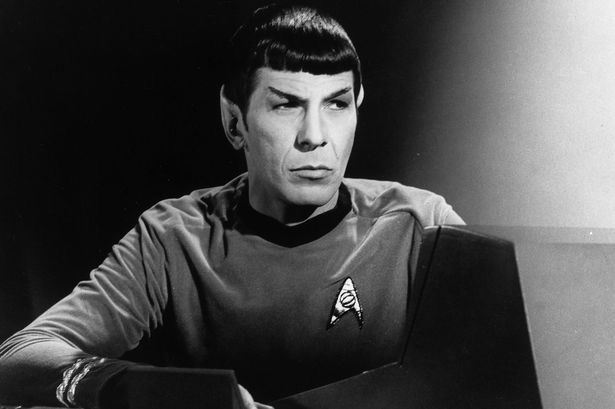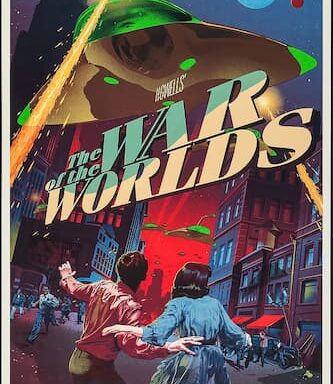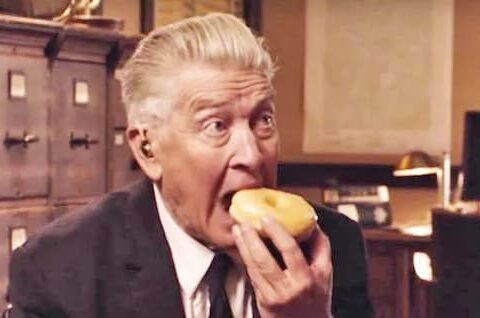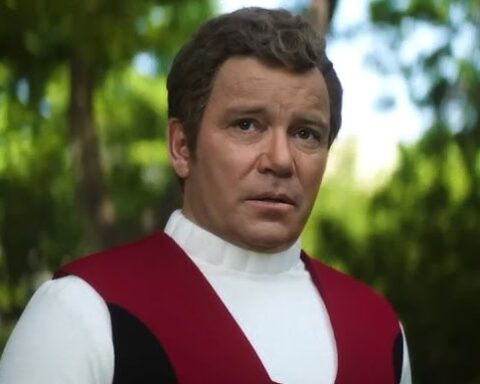Across three seasons of groundbreaking television with Star Trek (and several movies), Leonard Nimoy’s iconic character, Spock, had more memorable moments than can be counted.
Just as the likes of Kirk and McCoy did. He had some awful ones too (let us never speak of ‘Spock’s Brain’); but so many great moments or scenes were written for him by the Original Star Trek series’ roster of talented and innovative writers, all played with that perfect, nuanced Nimoy understanding of the character.
And so many great scenes or moments of interplay between Spock, Kirk and McCoy; the interplay that formed the core of what made the series so popular.
I won’t go back into paying tribute to Nimoy or explaining why Spock was so important; I already did that here. You can also still download the podcast tribute to Nimoy I did with Mumra 2k from this link.
Picking just ten such moments from that rich library of Star Trek material is difficult, but where Spock is concerned, some of those highlights are so obvious and stand out so clearly that the job is that little bit easier than it might be for Kirk, McCoy, Data, Odo, Dax or any of the other great characters Star Trek has produced over the years.
Of course, it has to be said that for all the endearing, engaging or memorable characters the franchise has given us over the decades since its inception, there remains a degree of almost universal affection for those characters of the original series that will probably never be matched; and even among that privileged group of characters and actors, Spock and Nimoy arguably remain the most celebrated, the most loved. “Given the choice”, Nimoy once said, many years after the series was over, “If I had to be someone else, I would be Spock.”
These are 10 moments picked out from the vast Star Trek canon that for various reasons most represent or exhibit what has always been fascinating about Spock and Leonard Nimoy’s long-time, layered depiction of that character…
INTO THE V’GER CLOUD… (Star Trek: The Motion Picture 1979)
Though the first Star Trek movie still comes in for a lot of criticism (much of it justified), there is still enough of interest in the movie to warrant multiple viewings. I hated this film when I first saw it, though admittedly I only saw it after I’d already been exposed to three of its sequels and was probably spoilt by the quality, pacing and excitement of those. By comparison, Star Trek: TPM is very slow, and frankly dull in large sections, despite having a very strong, intriguing premise and being more of a ‘science fiction’ film in the classic sense than any of its follow-ups. One of the best things about the movie is Spock himself, who, after the V’Ger anomaly itself, provides the most fascination.

The early sequence on Vulcan of Spock failing to attain ‘Kolinhar’ (a state of complete, perfect logic) is one of the most iconic, visually striking images of Spock in all the vast ST canon.
But much later on, Spock’s space-suit thrust into the heart of the V’Ger anomaly is even more memorable and is one of the most visually stunning sequences in all Star Trek and possibly in all cinematic science fiction. The flowing sequences of alien, otherworldly images are hypnotic, with Spock at the center of it, being as fascinated and compelled as we as viewers are. This sequence, and in fact large parts of this film overall, really take us back to that state of wonder and fascination with the unknown that could be said to have been at the heart of science fiction prior to the more modern emphasis on action and pacing.
‘THE NAKED TIME’ (Star Trek: The Original Series, Season One, 1966)
Picking out specific episodes or moments from the original Star Trek series is difficult, as Leonard Nimoy, like William Shatner and DeForest Kelley, had cool or classic moments scattered through virtually every episode, even the otherwise bad episodes. But this first season episode was in theory the earliest occasion in the original series where viewers witnessed Spock’s typically unwavering Vulcan veneer slip a little, when he briefly lets himself go and loses his practised emotional control; in this instance it is due to the crew contracting a virus that causes all inhibitions to evaporate. ‘The Naked Time’ represents viewers’ first indication that Spock’s Vulcan suppression of his emotions wasn’t simply nature but was a continuous, strained effort and that it may have gone against the true inclinations of his very being.
This sense of intense inner struggle would come to be a defining characterstic of Nimoy’s character throughout his rich fictional life, and ‘The Naked Time’ could be regarded as the point after which our understanding of the character changed forever. Nimoy’s performance of this juxtaposition in this 1966 first-season episode is particularly remarkable.
‘AMOK TIME’ (Star Trek: The Original Series, Season Two, 1967)
A bit of an obvious one, but no understanding of Spock would be valid without reference to the classic second season episode that set the playing field for so much of Star Trek‘s subsequent characterisation of Vulcans and Vulcan culture (it it also the first instance of both the iconic Vulcan hand salute and the ‘Live Long and Prosper’ greeting that Nimoy unintentionally put into such wide currency). It is also probably the defining centerpiece for Spock in the original TV series. Subject to the crippling Vulcan condition known as the Pon Farr, all emotional control is lost: the only solution is for Spock to return to Vulcan and mate… or die. The premise once again gave Nimoy the chance to break out of the standard Spock veneer and play the ‘beast unleashed’ motif to great effect.

In Kirk’s taking Spock home I also always perceive a vague echo of events in the third Star Trek movie, in as much as representing Kirk’s devotion to his friend and his needs (I should add, however, that I wasn’t born when the series was first airing and I saw Star Trek III: The Search For Spock before I saw ‘Amok Time’). The Kirk/Spock arena battle is of course one of the most memorable and referenced moments of the original series (exceeded only perhaps by Kirk’s famous battle with the Gorn), and Spock’s response to T’Pau’s “live long and prosper” is one of the greatest Spock lines: “I shall do neither.” Spock, having defeated Kirk and believed the captain is dead, returns to the Enterprise grim and inconsolable. His reaction when he finds Kirk alive on the ship is as priceless today as it ever was, as the Vulcan’s usually hidden feelings leap out to the surface and Spock is unable to hide his joy – if only for the briefest of moments. Nimoy has stated that “within two weeks after (‘Amok Time’), my mail jumped from a few hundred letters to 10,000 a week.”
“WHAT DO YOU THINK OF MY SOLUTION…?” (Star Trek II: The Wrath of Khan, 1982)
It goes without saying, of course. Not only the most iconic Spock/Kirk moment, but probably the most iconic Star Trek moment entirely and in my opinion the most poignant and permanently resonant ‘death scene’ that I can think of in any medium or mythology (Messalla’s death in Ben Hur might be a close contender, or Claudius’s in the classic I, Claudius TV series); partly because the second and third Star Trek movies are on a broader level such an epic, beautiful exploration of life, death, ageing and the mysteries of existence in the first place.
I was seven years old when I first saw this on TV and it stayed with me forever. I tend to watch Star Trek II and III on a yearly basis and every time we get to this part of the film I have the same emotional reaction, no matter how many times I’ve seen it before: from the moment Kirk looks over and sees Spock’s chair empty, it’s all heart-in-mouth time. While the scene of Spock’s burial tube being shot out into space towards the Genesis planet is actually a moment that gets me even more than the famous Kirk/Spock farewell, for most people the image of Kirk and Spock separated by the wall of glass, unable to touch hands, is the bit forever embedded into the visual/emotional memory.
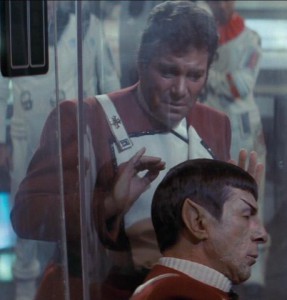
It could be said to be a scene about heroism, but actually it’s a scene more than anything else about friendship and about platonic love. We feel Kirk’s helplessness and sorrow as he watches his friend expire on the other side of the glass.
Watching it for the fifty-seventh time, it occurs to me that part of what is so effective in how this scene was executed is in how understated it is; for a dramatic ‘death scene’, it isn’t overwrought. Kirk’s reaction is as perfectly depicted by Shatner as could be imagined, exactly the right mix of restraint and emotion, while Spock’s talk of the “Kobiyashi Maru test” and asking if the ship is “out of danger” is precisely the kind of logical, priority-minded question we’d expect from him even as the life is expiring from his ravaged body.
Pure, unforgettable, cinematic perfection. The recent Star Trek: Into Darkness take on this famous scene (but with the roles reversed so that Kirk is the injured party behind the glass) was more homage than replication of effect or power, illustrating that you can up the budgets and the bombast, but you can’t recreate the conditions, the emotions, the performances or the pathos.
“YOUR NAME IS… JIM!” (Star Trek III: The Search For Spock, 1984)
Having gone through the emotional wringer of The Wrath of Khan, the follow-up film The Search For Spock might’ve been criticised for its restoration of Leonard Nimoy’s character to life, which could’ve been viewed as an early example of that future Star Trek trademark, the ‘reset button’. However, Star Trek III was so good, so beautifully done, and the resurrection of Spock so grounded in logic (the puzzle pieces were clearly laid out in Star Trek II) and at the same time so bound up in emotive, poignant themes and characterisation that only the most unfeeling, hard-hearted sceptic would still be levelling that criticism by the end of the movie.
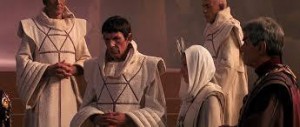
While Spock was the hero in Star Trek II, in III it’s all about Kirk’s heroism; but moreover about his devotion to friendship. Yes, Star Trek III even more than II is a film about platonic love and the lengths James Kirk will go to honour the memory of his friend, even for the sake of an “immortal soul” that he might not even believe in. Spock himself barely appears in the film, which gave Nimoy plenty of space to direct the movie: which he did to beautiful effect, this movie brimming with tone and atmosphere. It’s Spock’s emergence in the film’s climatic scene, having been returned to Vulcan and administered to by the Vulcan priests, that is the magic Nimoy moment. When a lost-looking Spock emerges, dressed in his religious-looking robe, and beholds his gathered friends with blank-faced uncertainty, we wonder how much of ‘Spock’ as a personality has survived his resurrection ordeal.
When finally, after an agonisingly long delay, he turns back to Kirk with the faintest flicker of recognition and hesitantly mutters “Jim… your name is Jim!” we breathe a collective sigh of relief, knowing that although he may never be quite the same Spock as before, the essence of Spock is still in there, still alive and with us.
To my continuing dismay, Star Trek III still doesn’t tend to be regarded as one of the best ST films, but for me it comes right after The Wrath of Khan on the list.
JOURNEY TO BABEL (Star Trek: The Original Series, 1967)
Aside from being the TOS episode that gave us Andorians and the Coridan, it was also the episode to introduce Spock’s family; his father Sarek (portrayed wonderfully by the late Mark Lenard over three decades) and his human mother, Amanda Grayson (Jane Wyatt). What we discover is that Spock doesn’t have a happy or harmonious relationship with his parents and is estranged from his father, who disapproves of his career. It is essential coloring to Spock’s character, which would prove important to our understanding of him; the fact that he has a human mother and is therefore not full Vulcan.
This is something that causes him an inner conflict, even embarrassment. It also makes it doubly difficult for him to maintain his Vulcan discipline, much more so than for other, full Vulcans.
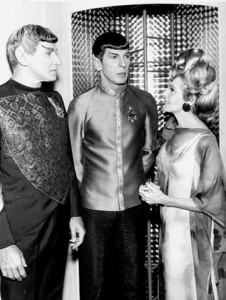
It is curious too that in this episode we see Spock acting out of pure, emotionless logic; he stubbornly insists on remaining on the bridge and commanding the ship through a crisis instead of donating the blood that will help save his father’s life. What appears coldhearted to McCoy and to Spock’s mother is in fact precisely the kind of duty-minded logic and rationality that a Vulcan is expected to operate by and that Spock himself has always sought to master.
SPOCK’S BEARD (‘Mirror, Mirror’, Star Trek: The Original Series, 1967)
The ‘Mirror Universe’, first introduced in the original Star Trek series, has become a staple not only of the Star Trek franchise (with both Deep Space Nine and Enterprise having returned to it), but of science-fiction and popular culture in general.

So much so that the donning of a goatee beard has become shorthand for indicating an evil, alternate universe version of a character (which, being a goatee-wearer myself, I slightly resent); both South Park and Futurama paid hilarious homage to this, with evil, goateed versions of Cartman and Bender respectively.
DS9 and Enterprise’s forays into the Mirror Universe were among those series’ poorer and more cliched offerings (particularly for a series as otherwise superb as DS9), but the original ‘Mirror, Mirror’ was a revelation and was in fact one of the series’ best (and most famous) episodes. And what everyone remembers is Evil Spock and that beard; a moment so famous that it has a band named after it – literally, just Spock’s Beard. It is curious to note that the original series’ sole exploration of the Mirror Universe remains the best, even though two much later Star Trek incarnations tried much more expansive, ambitious stories using the same premise.
SPOCK TAKES THE CHAIR (Star Trek: The Undiscovered Country, 1991)
While the sixth entry into the Star Trek movie franchise has never been one of my favorites (as a general movie, I prefer The Final Frontier), it undoubtedly has its strong points. My problem with it was always that it seriously drops in quality after what is a superb opening hour or so. But Spock, as usual, is central to what does work so well in this movie. His exchanges with Kirk early on, particularly the “they’re dying/let them die” dialogue, are some of the film franchise’s best exchanges, with Spock now playing the role of idealist and peacemaker (echoed in the TNG two-parter ‘Unification’) while Kirk, embittered by the events of Star Trek III and his history with the Klingons in general, is the unwavering hawk.
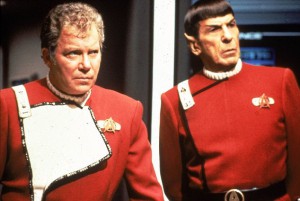
The themes around whether the likes of Kirk and Spock have ‘outlived their usefulness’ in the galaxy are in essence as interesting as the coming-to-terms-with-age themes of Star Trek II, though much less explored. But what The Undiscovered Country really gives Spock and Nimoy is the chance to take center-stage as galactic detective, trying to solve the mystery of the Klingon Chancellor’s assassination and rescue his friends Kirk and McCoy from certain death in the grim penal colony.
Though the movie loses steam after a certain amount of time, this race-against-the-clock investigation, with all its logical deductions and analyses, is the kind of role Spock was born to play and feels like a pleasant link back to some of Spock’s best moments in the sixties TV series. His mentor/protege relationship with Kim Cattral’s Valeris is also a source of compelling scenes, echoing the Saavik (Kirstey Alley) relationship in Star Trek II, while the early Spock/Valeris scene in which the older Vulcan ‘passes the torch’ in reference to his old age and inevitable mortality was always poignant, but seems all the more resonant now in the wake of Nimoy’s real-world passing.
SPOCK And DATA (Star Trek: The Next Generation, ‘Unification’, 1991)
Leonard Nimoy’s at-the-time much hyped appearance in The Next Generation was certainly a source of great excitement at the time of airing. With hindsight the ‘Unification’ two-parter isn’t that great an entry overall, though it does have its high points, such as that initial Spock/Picard encounter and in particular Spock’s brief one-to-one with perhaps Nimoy’s equivalent fixture in the TNG set-up, Commander Data. In said scene, we realise that the two characters, though comparable in various ways, differ in an especially curious way: Spock has spent his life trying to suppress his human side, while Data has spent his longing to be more human and to know what it is to be human.
In some ways, Nimoy’s appearance in TNG might’ve been perceived by some as a vindication or ‘acceptance’ of the second generation of Star Trek from the old-guard pioneers; DeForest Kelley had already appeared in the TNG pilot episode, but Nimoy had been known to have expressed misgivings about The Next Generation at its inception and his involvement in this two-part story might therefore be perceived as a sort of coming-to-terms with the passing of the Trek legacy onto new generations. Nimoy famously declined to appear in the 1994 Star Trek: Generations movie that was designed to send off the original cast and initiate the line of TNG feature-films; you can’t help but feel he made the right choice. While that film made a complete mess of Captain Kirk’s death, ‘Unification’ at least dealt with Spock in a more dignified way, even if the story ultimately loses momentum.
LAST MAN STANDING: (Star Trek, the 2009 Reboot)
Alright, so the 2009 reboot of the Star Trek franchise is as divisive as anything gets within Trek fandom. Some love it (particularly newbies), some loathe it, some refuse to watch it, some are a pretty neutral. I personally find them very entertaining, well-made films, though they’re never in danger of superseding my regard or affection for the original Star Trek film franchise and its cast. Chris Pine, Zachary Quinto and the rest of the new bunch are all fine (particularly Keith Urban, who does an amazing DeForest Kelley), but Shatner, Nimoy and the original cast will always be the standard. In terms of Nimoy’s role in both the new films, it serves to bridge the two franchises instead of having them be completely divorced from one another.
I didn’t initially enjoy seeing Nimoy in these films, mainly because I didn’t like seeing him so old and frail-looking; I didn’t like seeing Shatner in 1994’s Star Trek: Generations either. But in terms of the story, our Spock’s role in it is one of the best elements, creating a visually stunning sequence during the flashback-explanation in the 2009 movie, while the young Kirk/older Spock encounter is genuinely engaging, even poignant in places. Nimoy also appears in the sequel Into Darkness, but whether or not he had filmed any scenes for the third movie is unknown at this point.
There could be more than ten such moments, of course: such is the scope of Nimoy and Spock’s onscreen legacy. In my estimation, however, these are ten of the absolutely key and best Spock/Nimoy landmarks in Star Trek. May the great man reside in peace.
